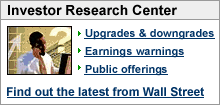Dow sees best day of '07 post-FedMajor stock gauges jump, with Dow seeing best day of the year; investors interpret central bank statement as meaning a rate cut could be on the horizon.NEW YORK (CNNMoney.com) -- Stocks and bonds rallied Wednesday as investors read the latest Federal Reserve policy statement as implying that the central bank is more likely to cut rates than raise them anytime soon. The central bank also soothed the market by downplaying the impact of the fallout in the subprime lending sector by not acknowledging it at all, a surprise to some investors. The Dow Jones industrial average (up 159.42 to 12,447.52, Charts), the Nasdaq (up 47.71 to 2,455.92, Charts) composite and the broader S&P 500 (up 24.10 to 1,435.04, Charts) index all surged. The Dow added 159.42 points and saw its best one-day point gain since July of last year. All three major gauges had posted slim gains ahead of the news but jumped after the announcement. Treasury prices rose, lowering the corresponding yields. The dollar fell versus other major currencies. After the close of trade, Motorola (Charts) warned that it will post a first-quarter loss and that its revenue will miss forecasts, owing to weak sales of mobile devices. Shares slumped more than 5 percent in extended-hours trading. The company also said that its chief financial officer would retire effective April 1. Thursday morning brings earnings news from KB Home (Charts) and the February index of leading economic indicators. Fed policy-makers concluded their two-day policy meeting Wednesday by keeping the Fed fund rate, a key overnight bank lending rate, unchanged at 5.25 percent for the sixth meeting in a row, in line with expectations. In the closely watched statement, the central bankers changed the language to suggest that they were a bit more worried about the slower economy than previously, noting that "recent indicators have been mixed." In addition, the statement no longer said "additional firming may be necessary." Investors took this omission as implying that the Fed was more likely to cut rates going forward than raise them. However, that may not be the case. "There seems to be an interpretation that they are throwing a bone to the doves, but I don't think that's right," said Michael Darda, chief economist at MKM Partners. "They reiterated that the predominant concern going forward is inflation." In light of that, Darda said the decision to remove the phrase "additional firming" was stupid, in that it has confused investors, giving them the impression that the bank is less worried about pricing pressure than it is. The bankers were trying to soften their rate hike or tightening bias, said Stephen Stanley, chief economist at RBS Greenwich Capital, rather than shift toward easing, a significant semantic difference. "This was a baby step toward symmetry," Stanley said. However the result, judging from the market euphoria, is that the statement has "exacerbated the gap between the Fed's perception of the economy and the bond and stock market perception." The market reaction also suggest that investors are "not as concerned about inflation as the Fed is," said Georges Yared, chief investment officer at Yared Investment Research. In addition to the inflation-related language, the central bankers surprised some investors by not referring to the recent fallout in the subprime mortgage lending market, only noting that "the adjustment in the housing sector is ongoing." However, the economists seemed to think that was a positive, noting that subprime may have less of an impact on the overall economy than the recent stock gyrations would suggest. Treasury prices cut losses and turned higher after the Fed announcement. The advance sent the yield on the 10-year note down to about 4.54 percent from about 4.58 percent before the meeting and 4.55 percent late Tuesday. Bond prices and yields move in opposite directions. In currency trading, the dollar declined versus the euro and trimmed gains versus the yen after the announcement. Among stock movers, 29 out of 30 Dow components rose, with Alcoa (down $0.22 to $33.85, Charts) the only decliner. Standouts to the upside included Microsoft (up $0.68 to $28.52, Charts) and the Dow's other tech components and Citigroup (up $1.39 to $52.03, Charts) and the Dow's other financial stocks. Morgan Stanley (up $5.22 to $81.33, Charts) shares jumped after the bank reported higher earnings that topped estimates. Oracle (up $0.62 to $18.17, Charts) shares also climbed after the software maker posted quarterly sales and earnings that rose from a year ago. Earnings were released after the close Tuesday. Also after the close Tuesday, Adobe Systems (up $2.56 to $43.30, Charts) reported higher profits that topped estimates on lower sales that missed forecasts. The stock gained more than 6 percent Wednesday. On Wednesday, FedEx (down $1.30 to $110.99, Charts) reported lower quarterly earnings that topped estimates and issued a 2007 forecast that is short of expectations. Shares slipped. (Full story) SanDisk (up $1.57 to $43.48, Charts) rose after the flash memory chip maker reached a patent agreement with South Korea's Hynix Semiconductor. On the downside, U.S. Auto Parts Network (down $4.58 to $6.49, Charts) sank 41 percent in unusually active trading after reporting a fourth-quarter net loss late Tuesday, down from a profit a year ago. The auto parts retailer also issued a first-quarter and full-year 2007 earnings outlook that is short of forecasts. Market breadth was positive. On the New York Stock Exchange, winners topped losers by nearly 5 to 1 on volume of around 1.63 billion shares. On the Nasdaq, advancers beat decliners 11 to 4 on volume of 2.21 billion shares. U.S. light crude oil for May delivery rose 1 cent to settle at $59.61 a barrel on the New York Mercantile Exchange. Oil prices were volatile following the release of the weekly oil inventories report. COMEX gold for May delivery rose $1 to settle at $660 an ounce. Subprime: the risk to Wall Street |
|





